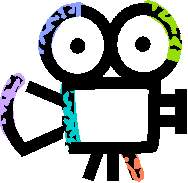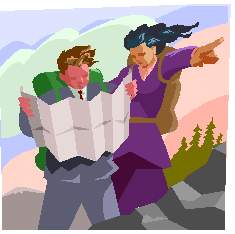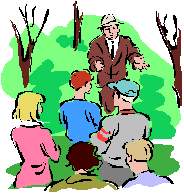|
Notes on Narrative Writing
|
Narration is a kind of
writing that comes very naturally to most of us. Plainly said,
narration is story
telling. If we think of description as capturing
a
 subject, object or scene as a snapshot, we
can think of narrative as what a movie camera might
capture; that is, a series of scenes that may include
conversation, background information, material that
may help a reader (viewer) understand the story
subject, object or scene as a snapshot, we
can think of narrative as what a movie camera might
capture; that is, a series of scenes that may include
conversation, background information, material that
may help a reader (viewer) understand the story (meaning/point) as it is presented.
(meaning/point) as it is presented.
In most pure description, meaning
and feeling will probably be implied just by language the writer
uses. In
narration, we get to fill in the implications of the
topic and further lead the reader to find a thread of meaning.
Just as a description tends to freeze time
and focus the reader on that element, object or
scene, narration tends to move through time. Description
is characterized by data from the 5-senses with only
an implied meaning, narration is characterized by a
information that
1) locates the reader in time and space and moves through
time and space,
2) has an "identifiable" teller of the
account
3) makes or strongly implies a point that
offers the reader a significant idea
(meaning) to take away.

1)Narration locates the reader in time and space: Narration,
then, starts somewhere (time and place), moves around, and
ends somewhere. Narration can also be thought of as a parade
of places, events and ideas that could be connected
with the words "and then" to give a clear sense of
movement through time and place (aka in fiction, as plot). But any movement through
time will serve, i.e., natural time sequence (past, present,
future), or any mix of those time settings in any order that
furthers the point ( present > flashback> flash
forward> simultaneous present, what-ifs, etc.). One definition of
narrative calls it a map to a path through the wilderness...
 2) Narration has an identifiable teller of the
account. This is called "point of view," that is,
from whose perspective this story is being told. If the
teller is in the first person, "I" is the
narrator's voice. If the story/account is being told by or
through another particular person ( though anything can be a
narrator...), usually a named person or the appropriate
pronoun ( he or she), the teller/narrative voice is said to
be in the third person. This element of
"teller" can take many guises and even an
"I" is not always the writer, especially in
fiction. Non-fiction or most all essay writing does usually
use an "I" as the teller, but sometimes may have no
clear "I" identified. In these cases, the absence
of a named or assumed "I" is known as a "disembodied narrator."
There are lots of other kinds of narrators, but most are tools of fiction
writers.
2) Narration has an identifiable teller of the
account. This is called "point of view," that is,
from whose perspective this story is being told. If the
teller is in the first person, "I" is the
narrator's voice. If the story/account is being told by or
through another particular person ( though anything can be a
narrator...), usually a named person or the appropriate
pronoun ( he or she), the teller/narrative voice is said to
be in the third person. This element of
"teller" can take many guises and even an
"I" is not always the writer, especially in
fiction. Non-fiction or most all essay writing does usually
use an "I" as the teller, but sometimes may have no
clear "I" identified. In these cases, the absence
of a named or assumed "I" is known as a "disembodied narrator."
There are lots of other kinds of narrators, but most are tools of fiction
writers.
3) Narration makes or strongly implies a point that
offers the reader a significant idea (meaning) to take away. This
element of narration is presented in countless ways, so this
is where the "proof of the pudding" usually shows.
As that old saying goes, the proof of the pudding is in
the eating, the proof of the narrative is usually in the
meaning that the reader can take away for use in the
real world. The meaning element is also the shaping
tool for the story/account. That is,
- where the story starts,
- how and where it moves,
- what descriptive details are included,
- what other information is included and, maybe most
obvious of all,
- how and where the story ends--comes
full circle--even if it is very subtle.

These qualities are all heavily influenced by what the writer
states or implies as the meaning (or point or lesson) of the
writing. This meaning aspect of telling is the teaching element that
characterizes the use of story in many cultural traditions.
Human culture began with the oral telling of stories that passed along
history, beliefs, and everyday how-to information (medicinal plants, foods,
crafts, locations, etc.). Beyond the creative satisfaction of making and
sharing stories, this composing ability that we all use to recount
experiences (real or imagined), is also recognized as a tool in maintaining psychological
health and understanding our lives better.
So, narration-our ability to string together ideas and experience
(non-fiction or fiction)--is fundamental to other kinds of writing and
thinking. When we have our "train of thought" in place to convey
information in a way a listener or reader can follow, then we can use
various other compositional patterns (rhetoric) to fine-tune that process as
needed.
Almost any writing will include a
combination of description and narration. Creative elements such as
comparisons/metaphors that can help readers understand the material may also
be present to various degrees. These "artistic" qualities that may
or may not be strictly factual, are especially evident in what is now known
as "creative" or "literary" non-fiction. Since
"truth" and provable fact may be at best arguable notions, many
kinds of ideas and information might be best conveyed in various
"artistic" terms. Jacob Bronowski in an essay titled
"Likenesses" graphically illustrates how the world of hard science
actually relies heavily on such comparisons to explain ideas that are not
easily observed by non-scientists.
So, both narrative and descriptive
elements can help the reader have an experience of abstract ideas,
explanations, accounts
or stories. Again, if we think of a narrative/descriptive writing in cinematic
terms, a narrative might begin, say, with footage of a modern
New York City street at night (time and place), move to the close-up of a homeless man under a street light
(give 5 sense data), then shift to a scene of little boy on a farm during
the 1930’s (movement in time and place), then footage of
a storm that destroys the farm, (information) and so on, till the story of this person, say,
is told so as to convey a meaning. T his could be a movie and
this could also be the framework of a reporter’s
in-depth account on the homeless population. Fiction and
non-fiction have many shared elements and intentions.
Journalism is often the home of essay writing because the
meaning and narrator are often assumed to be the writer, and
who that is may have some bearing on the impact of the
writing. Fiction writing may certainly arrive at
journalistic-type conclusions (i.e., history-based novels
like Exodus or The Winds of War) but work much
more in the what-if position than a non-fiction historically focused essay might.
This "new" kind of essay often
called "creative non-fiction" or "literary non-fiction" tends to blur the
boundaries of fiction and non-fiction, and is a perfectly fine
"form," for almost any writing. An idea credited to artist Pablo
Picasso has much to teach us in many aspects of life: Art is a lie that
tells the truth.
his could be a movie and
this could also be the framework of a reporter’s
in-depth account on the homeless population. Fiction and
non-fiction have many shared elements and intentions.
Journalism is often the home of essay writing because the
meaning and narrator are often assumed to be the writer, and
who that is may have some bearing on the impact of the
writing. Fiction writing may certainly arrive at
journalistic-type conclusions (i.e., history-based novels
like Exodus or The Winds of War) but work much
more in the what-if position than a non-fiction historically focused essay might.
This "new" kind of essay often
called "creative non-fiction" or "literary non-fiction" tends to blur the
boundaries of fiction and non-fiction, and is a perfectly fine
"form," for almost any writing. An idea credited to artist Pablo
Picasso has much to teach us in many aspects of life: Art is a lie that
tells the truth.
copyright © 2011 ~ Jane Thielsen ~ all
rights reserved
|
 subject, object or scene as a snapshot, we
can think of narrative as what a movie camera might
capture; that is, a series of scenes that may include
conversation, background information, material that
may help a reader (viewer) understand the story
subject, object or scene as a snapshot, we
can think of narrative as what a movie camera might
capture; that is, a series of scenes that may include
conversation, background information, material that
may help a reader (viewer) understand the story (meaning/point) as it is presented.
(meaning/point) as it is presented. 
 2) Narration has an identifiable teller of the
account. This is called "point of view," that is,
from whose perspective this story is being told. If the
teller is in the first person, "I" is the
narrator's voice. If the story/account is being told by or
through another particular person ( though anything can be a
narrator...), usually a named person or the appropriate
pronoun ( he or she), the teller/narrative voice is said to
be in the third person. This element of
"teller" can take many guises and even an
"I" is not always the writer, especially in
fiction. Non-fiction or most all essay writing does usually
use an "I" as the teller, but sometimes may have no
clear "I" identified. In these cases, the absence
of a named or assumed "I" is known as a "disembodied narrator."
There are lots of other kinds of narrators, but most are tools of fiction
writers.
2) Narration has an identifiable teller of the
account. This is called "point of view," that is,
from whose perspective this story is being told. If the
teller is in the first person, "I" is the
narrator's voice. If the story/account is being told by or
through another particular person ( though anything can be a
narrator...), usually a named person or the appropriate
pronoun ( he or she), the teller/narrative voice is said to
be in the third person. This element of
"teller" can take many guises and even an
"I" is not always the writer, especially in
fiction. Non-fiction or most all essay writing does usually
use an "I" as the teller, but sometimes may have no
clear "I" identified. In these cases, the absence
of a named or assumed "I" is known as a "disembodied narrator."
There are lots of other kinds of narrators, but most are tools of fiction
writers.
 his could be a movie and
this could also be the framework of a reporter’s
in-depth account on the homeless population. Fiction and
non-fiction have many shared elements and intentions.
Journalism is often the home of essay writing because the
meaning and narrator are often assumed to be the writer, and
who that is may have some bearing on the impact of the
writing. Fiction writing may certainly arrive at
journalistic-type conclusions (i.e., history-based novels
like Exodus or The Winds of War) but work much
more in the what-if position than a non-fiction historically focused essay might.
This "new" kind of essay often
called "creative non-fiction" or "literary non-fiction" tends to blur the
boundaries of fiction and non-fiction, and is a perfectly fine
"form," for almost any writing. An idea credited to artist Pablo
Picasso has much to teach us in many aspects of life: Art is a lie that
tells the truth.
his could be a movie and
this could also be the framework of a reporter’s
in-depth account on the homeless population. Fiction and
non-fiction have many shared elements and intentions.
Journalism is often the home of essay writing because the
meaning and narrator are often assumed to be the writer, and
who that is may have some bearing on the impact of the
writing. Fiction writing may certainly arrive at
journalistic-type conclusions (i.e., history-based novels
like Exodus or The Winds of War) but work much
more in the what-if position than a non-fiction historically focused essay might.
This "new" kind of essay often
called "creative non-fiction" or "literary non-fiction" tends to blur the
boundaries of fiction and non-fiction, and is a perfectly fine
"form," for almost any writing. An idea credited to artist Pablo
Picasso has much to teach us in many aspects of life: Art is a lie that
tells the truth.